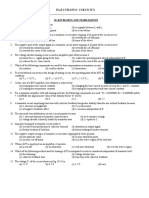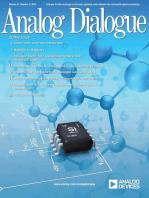Analog Circuits and Systems Through SPICE Simulations Assignment - 3
Uploaded by
cdmnpillaiAnalog Circuits and Systems Through SPICE Simulations Assignment - 3
Uploaded by
cdmnpillaiAnalog Circuits and Systems Through SPICE Simulations
Assignment -3
Attempt all questions
1. For a very high impedance biopotential electrode for a relatively low frequency signal, the input impedance of the frontend amplifier should be
preferably _____________ and can be implemented through _____________ coupling.
(a) low, resistive (b) high, capacitive (c) low, capacitive (d) high, resistive
2. The maximum applicable gain in the frontend may be primarily limited by
(a) power dissipation limit (b) large base-line drift (c) signal frequency (d) noise of the amplifier
3. _________ is the primary concern for the frontend amplifier, while _________ may be a more serious issue for the VGA :
(a) linearity, noise (b) noise, linearity (c) gain, noise (d) noise, gain
4. Capacitive feedback satisfies the ____________ requirement but complicates ___________ biasing considerations.
(a) input impedance, biasing (b) power, bandwidth (c) biasing, gain (d) bandwidth, impedance
5. For a fully differential amplifier with active load, with perfectly matched transistor pairs, what can create large uncertainity in output DC points
for given fixed bias at the gate of load devices, input devices and the current source device?
(a) uncertainty of threshold voltages (b) uncertainty of lambda (c) none (d) both
6. A fully differential amplifier with perfectly matched devices would have ________ PSRR with if the output is taken differentially
(a) infinite (b) zero (c) very large (d) very small
7. Differential to common mode conversion can result from
(a) mismatch between the input devices (b) mismatch between the load devices (c) supply noise (d) variation in tail current
8. Extracting common mode signal using resistive divider would result in :
(a) reduction in bandwidth (b) increase in area (b) reduction in gain (c) increase in output noise
9. The common mode feedback voltage can be applied to
(a) load device (b) tail current course (c) load device and tail current source (d) load device or tail current source
10. For a 2-stage fully differential amplifier wit NMOS input device, the 1st stage CMFB amplifier should have ___ input and 2nd stage ____ input:
(a) PMOS , NMOS (b) NMOS, PMOS (c) NMOS, NMOS (d) PMOS, PMOS
11. The CMFB can be seen as a __________ feedback topology, while opening the loop between the output of the main amplifier and the error
amplifier
(a) shunt-shunt (b) shunt-series (c) series-shunt (d) series – series
12. The CMFB loop bandwidth must be equal to the main amplifier’s closed loop bandwidth:
(a) False (b) True
You might also like
- Service Manuals LG TV LCD 42LG61YD 42LG61YD Service ManualNo ratings yetService Manuals LG TV LCD 42LG61YD 42LG61YD Service Manual45 pages
- Second Quarter - Module 35: MathematicsNo ratings yetSecond Quarter - Module 35: Mathematics23 pages
- Knowledge Check: Operational Amplifier: Aol AcmNo ratings yetKnowledge Check: Operational Amplifier: Aol Acm2 pages
- Multiple Choice Linear Electronics Circuits - 102409023651 - 150% (2)Multiple Choice Linear Electronics Circuits - 102409023651 - 115 pages
- ae-sdo-pe-2012-electronics-engineering-iiNo ratings yetae-sdo-pe-2012-electronics-engineering-ii10 pages
- B.Tech/Aeie/3 SEM/AEIE 2101/2016 B.Tech/Aeie/3 SEM/AEIE 2101/2016No ratings yetB.Tech/Aeie/3 SEM/AEIE 2101/2016 B.Tech/Aeie/3 SEM/AEIE 2101/20162 pages
- Objective Type Question and Answer For Electronics and Communication EngineeringNo ratings yetObjective Type Question and Answer For Electronics and Communication Engineering10 pages
- Most Important Interview Questions For Electronics Communication EngineeringNo ratings yetMost Important Interview Questions For Electronics Communication Engineering11 pages
- Certcdavao: Instruction: Select The Correct Answer For Each of The FollowingNo ratings yetCertcdavao: Instruction: Select The Correct Answer For Each of The Following4 pages
- Analog Circuits: Time Allotted: 3 Hrs Full Marks: 70No ratings yetAnalog Circuits: Time Allotted: 3 Hrs Full Marks: 704 pages
- Introduction To Communication Systems - QuizizzNo ratings yetIntroduction To Communication Systems - Quizizz4 pages
- Circuit Debugging Preliminary Round-Set 1: - T/T - T/T 2 - T/TNo ratings yetCircuit Debugging Preliminary Round-Set 1: - T/T - T/T 2 - T/T2 pages
- Ekt Sample Paper Electronics and Communication EngineeringNo ratings yetEkt Sample Paper Electronics and Communication Engineering10 pages
- Analog Circuits and Systems Through SPICE Simulations Assignment - 2No ratings yetAnalog Circuits and Systems Through SPICE Simulations Assignment - 22 pages
- Btech Eee 3 Sem Analog Electronic Circuits Pel3i102 2018No ratings yetBtech Eee 3 Sem Analog Electronic Circuits Pel3i102 20182 pages
- Multiple Choice Questions: S. Y. B. Sc. Physics Paper - II, Sem-III100% (1)Multiple Choice Questions: S. Y. B. Sc. Physics Paper - II, Sem-III11 pages
- TNEB ECE Model Question Paper 1: B) InfiniteNo ratings yetTNEB ECE Model Question Paper 1: B) Infinite8 pages
- 1693307612_Question_Papers_-_SEA_to_AE_Examination_-_2002No ratings yet1693307612_Question_Papers_-_SEA_to_AE_Examination_-_200217 pages
- Quiz No.1: (C) Flash-Over of InsulatorsNo ratings yetQuiz No.1: (C) Flash-Over of Insulators32 pages
- Test Paper:6 Paper Type: Whole Testpaper Test Date: 26 December 2010 Test Location: Chennai Posted By: SanjayNo ratings yetTest Paper:6 Paper Type: Whole Testpaper Test Date: 26 December 2010 Test Location: Chennai Posted By: Sanjay9 pages
- MME Electrical Session 1 Electrical FundamentalsNo ratings yetMME Electrical Session 1 Electrical Fundamentals22 pages
- Power Systems T - D (Q - Bank - Transmission)No ratings yetPower Systems T - D (Q - Bank - Transmission)60 pages
- Advanced Multicarrier Technologies for Future Radio Communication: 5G and BeyondFrom EverandAdvanced Multicarrier Technologies for Future Radio Communication: 5G and BeyondNo ratings yet
- Unit - 4 Artificial Intelligence AssignmentNo ratings yetUnit - 4 Artificial Intelligence Assignment13 pages
- Ambree's Meatless Patty Product Proposal - MarketingNo ratings yetAmbree's Meatless Patty Product Proposal - Marketing9 pages
- Advantages and Disadvantages of TechnologyNo ratings yetAdvantages and Disadvantages of Technology1 page
- Airbus A350 Firm Orders: Commandes Fermes - FESTBESTELLUNGEN - Pedidos en FirmeNo ratings yetAirbus A350 Firm Orders: Commandes Fermes - FESTBESTELLUNGEN - Pedidos en Firme2 pages
- 10 9MA0 01 9MA0 02 A Level Pure Mathematics Practice Set 10No ratings yet10 9MA0 01 9MA0 02 A Level Pure Mathematics Practice Set 105 pages
- Image Cse No Model No Part No DescriptionNo ratings yetImage Cse No Model No Part No Description4 pages
- Military-Grade Fabric Resists Large Rips: PPE E ENo ratings yetMilitary-Grade Fabric Resists Large Rips: PPE E E2 pages
- Dissimilar Welding of AISI 309 Stainless Steel To AISI 1020 Carbon Steel Using Arc Stud WeldingNo ratings yetDissimilar Welding of AISI 309 Stainless Steel To AISI 1020 Carbon Steel Using Arc Stud Welding6 pages
- Mastercam 2018 Mill Essentials Professional Courseware 1st Edition Mariana Lendel - Download the ebook now and read anytime, anywhere100% (4)Mastercam 2018 Mill Essentials Professional Courseware 1st Edition Mariana Lendel - Download the ebook now and read anytime, anywhere63 pages
- Target: Before Proceeding Further, Check How Much You Know About BusinessNo ratings yetTarget: Before Proceeding Further, Check How Much You Know About Business16 pages
- Manual de Instalare Unitate de Control Umirs QuadroSenseNo ratings yetManual de Instalare Unitate de Control Umirs QuadroSense26 pages
























































































